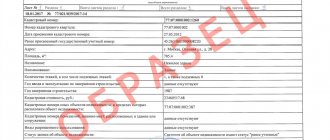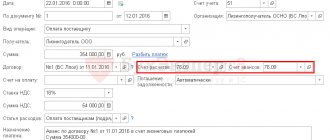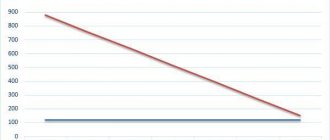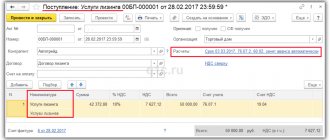The need to calculate depreciation of buildings
Buildings, as part of the assets of the enterprise, are used to support the production process and for administrative (management) purposes. Over the years, they gradually wear out, which is natural. Buildings lose their original properties and characteristics. As the technical condition deteriorates, their value decreases. When property is first entered into accounting records, it has an initial value. It is initially determined by the purchase price and the costs of putting it into operation.
Along with normal wear and tear, the value is subject to downward adjustment. That is why depreciation is calculated as a gradual attribution of the cost of fixed assets to the cost of goods manufactured, services provided or work performed.
What are depreciation charges?
These are monthly transfers of the value of non-residential real estate in parts in monetary terms to a special account, which is called “depreciation”. According to Art. 259 of the Tax Code of the Russian Federation, these deductions must be made by all organizations, taking into account the book value of real estate, which is their property. There are some buildings to which this law does not apply, since they are simply mothballed.
Any room wears out and becomes obsolete physically and morally as it is used.
Depreciation has the following purposes:
- use the transferred funds to improve existing or purchase new real estate as necessary;
- distribute large expenses in parts over periods, on an accrual basis;
- investors get the impression that the company does not have large expenses and losses, since at the end of its service life there will not be a huge figure in the report for write-off of the facility, which will seem like a loss-making amount for investors;
- payment of income tax is reduced.
All this helps reduce the owner’s losses on maintenance and subsequent write-off of the non-residential property.
Depreciation in accounting: basics
The starting element in the methodology for calculating depreciation is the useful life (LPI) of real estate assets. It is installed following the data of the “Classification of fixed assets included in depreciation groups.” It operates in accordance with government decree in 2002. It is also necessary to take into account the changes made on 07/07/2016. Their action began in January of this year.
The SPI is the period during which the building is able to serve productively as an asset and contribute to the accomplishment of the taxpayer's objectives.
The enterprise determines it itself, based on the date the building was put into operation and information about the OS classification: (click to expand)
| OS groups (buildings incl.) | SPI (years) | |
| over | up to (inclusive) | |
| 4th | 5 | 7 |
| 5th | 7 | 10 |
| 7th | 15 | 20 |
| 8th | 20 | 25 |
| 9th | 25 | 30 |
| 10th | 30 | |
The buildings belong to the 4th and 5th, as well as to 7-10 groups. The enterprise independently determines which of them its real estate should be classified as. The characteristics of each set of buildings provide a clue.
Is it possible to find out the wear and tear period of an object?
The depreciation period must be determined by the owner himself, based on the classification of fixed assets.
itself is defined as the number of years of use of a particular object . It depends on many factors, so all figures in the legislation are approximate values.
In order to roughly calculate the period of operation of non-residential premises, you need to know the following parameters:
- Service life of the main structural elements of the room.
- How the facility is operated. The level of wear and tear of the building depends on this.
As for the structural elements of the object, the numbers for calculating are as follows:
- parquet floors - 50 years;
- concrete foundation - 125 years;
- roofing ceramic coating - 80;
- wooden floors - 60;
- brick walls - 125.
These are not all the numbers; a complete list can be found in special documents.
After assessing the technical condition, the degree of wear and tear of the building is determined:
- good condition - up to 10%;
- quite satisfactory - 11-20%;
- satisfactory - 21-30%;
- not quite satisfactory - 31-40%;
- unsatisfactory - 41-60%;
- dilapidated - 60-80%;
- emergency - more than 80%.
To clarify the depreciation period of buildings, you must contact the Classifier and take into account Government Decree No. 1 of 01.01.2002, clause 1 of Art. 258 Tax Code of the Russian Federation. It is these documents that regulate the calculation of the depreciation period of non-residential properties.
To determine the percentage of wear and tear of the premises, it is necessary to invite specialists who will conduct research.
This examination includes:
- visual inspection of the building;
- technical examination of physical wear and tear;
- analysis of samples and research in the laboratory;
- verification of design and estimate documentation and its preparation in case of redevelopment;
- final report on the condition of the premises.
Then the obsolescence of the building is assessed taking into account the assessment of the real estate market at the time of the calculations. Based on all the data, the service life of the object is determined.
Building depreciation: wiring
The account used for depreciation is 02. Accounting entries reflecting the transactions:
| Debit | Credit | Operations |
| 20 | 02 | depreciation accrued in production: – mainly |
| 23 | – auxiliary | |
| 29 | – serving | |
| 25 | depreciation of fixed assets for general production purposes | |
| 97 | depreciation of fixed assets in deferred costs |
General rules for accounting
There are general rules that an accountant must follow when calculating depreciation of non-residential premises and non-residential buildings. These include:
- accruals occur monthly in the amount of 1/12 of the amount calculated for the current year;
- during the SPI, depreciation accrual is not suspended;
- accrual stops from the first day of the following month after the amount of the cost of the fixed asset has been fully repaid or it has been removed from the company’s books.
Everything is described in detail in instructions No. 157 N.
Calculation of depreciation of buildings in tax accounting
Tax legislation provides two ways to calculate depreciation of buildings:
- Linear – depreciation is calculated evenly and separately for each object. Regardless of the accounting policy of the organization, it must be applied to buildings. The basis for the calculation is their initial cost.
- Nonlinear.
The linear method is described above (example No. 1).
When applying the nonlinear method:
- The amount of depreciation should be calculated for the complex of buildings, and not for each one separately.
- The basis is taken as the residual value of the OS, not the original one. Their total assessment is reduced monthly by the accrued amount of depreciation.
Depreciation charges (A) are determined as follows:
A = Co Na, where:
Co – residual value of the building complex;
Na is the depreciation rate.
The size of the latter is:
| Depreciation group | Norm, % |
| 4 | 3,80 |
| 5 | 2,70 |
| 7 | 1,30 |
| 8 | 1,00 |
| 9 | 0,80 |
| 10 | 0,70 |
Example No. 2. The total residual value of buildings of the seventh group is 15 million rubles on the first day of the year. For the 7th group of fixed assets, the depreciation rate is 1.3%.
Let's calculate the amount of depreciation:
- January 15,000,000 · 1.3/100 = 195 thousand rubles.
- February (15,000,000 – 195,0000) 1.3/100 = 14,805,000 1.3/100 = 192,465
- March (14,805 – 192,465) 1.3/100 = 14,612,535 1.3/100 = 189,963
The residual value of the group of buildings at the beginning of the second quarter will be:
14,612,535 – 189,963 = 14,422,572 rubles.
Further calculations are carried out in exactly the same way.
In a non-linear way, the cost of buildings is written off much faster than in a linear way. The amount will be 35-40% in the first year of asset operation.
Important! The method is convenient to use in organizations that prefer accelerated depreciation.
Types of temporary structures
Temporary buildings and structures are divided into title and non-title structures, according to Decree of the State Construction Committee of Russia dated March 5, 2004 No. 15/1. Structures are divided based on their purpose. Title structures are used to meet the needs of construction as a whole, and non-title structures are used for individual construction projects. Examples of title and non-title buildings are listed below.
Title buildings
Title buildings, in particular, include:
- heated and unheated material warehouses;
- temporary sites for materials, products, equipment and loading and unloading operations;
- temporary mechanical repair and carpentry workshops;
- power plants, boiler houses, fan and commissioning works for them;
- temporary installations for cleaning and disinfection of surface water sources, etc.
Non-title buildings
Non-title structures are, for example:
- on-site offices and storerooms of foremen and craftsmen;
- storage facilities at the construction site;
- showers, unsewered latrines, and worker warming rooms;
- floorings, stepladders, stairs, walkways;
- temporary wiring from main and distribution networks of electricity, water, steam, gas and air within the work area, etc.
Features of depreciation calculations for reactivated and reconstructed buildings
When buildings are mothballed for a period exceeding three months, depreciation is paused. After the object is put back into production, it begins to be calculated again in the manner prescribed by the enterprise. The peculiarity is that it is necessary to increase the SPI of the building for the period it is in conservation - months or years.
This period also increases during reconstruction. It should only be taken into account that the SPI cannot exceed the service period established for the fixed assets of the corresponding depreciation group. When the period of time spent on reconstruction, major repairs or modernization of a building is more than a year, the depreciation process is suspended.
How to determine SPI: algorithm
When a company acquires a fixed asset - any kind - it needs to be depreciated, for which it is necessary to know the period of its planned useful use. In the table it is given in approximate time frames, but for each object it must be indicated precisely. The algorithm is as follows:
- Determine the OKOF code of your property using the OK 013-2014 classifier, approved by Rosstandart order No. 2018-st.
- Compare with the left column of the Classification table - determine which depreciation group your building and structure belongs to.
- Set any period from the given interval. For example, if the SPI is set at 10-15 years, you can prescribe 10 years 5 months, 12 years, 14.5 years, etc.
- Specify the established deadline in the text of the Order signed by the head of the organization.
- For accounting, set the SPI yourself or also use the Classification (this is much more convenient).
Depreciation of buildings during liquidation
In case of liquidation of fixed assets, they should be written off from the balance sheet. The transaction should be formalized by order of the manager and a Certificate of the appropriate form. In tax accounting, costs associated with liquidation, including underaccrued depreciation, are included in non-operating expenses. The following entries will be used in accounting:
| Debit | Credit | Write-off transactions |
| 01.2 | 01 | initial cost of disposed buildings |
| 02 | 01.2 | depreciation |
| 91.2 | 01.2 | residual value of buildings |
| 91.2 | 60 | Reflection of expenses for liquidation of OS |
How to calculate?
There are several methods for calculating depreciation in tax accounting. They have their own characteristics and differences, but at the first stage it is necessary to calculate the initial cost of the object.
The initial cost of a building is calculated from several parameters. First of all, the amount for the purchase or construction of this object. To this is added the amount spent on bringing the non-residential premises to normal condition, suitable for the necessary use.
This figure does not include VAT and excise taxes, except for certain exceptions that are prescribed in the Tax Code of the Russian Federation. If the object was received free of charge, then its value must be determined using an independent examination.
There are some cases where the initial cost may change. These include:
- completion and radical modernization of the premises;
- partial demolition;
- reconstruction.
Accrual methods
There are several ways to calculate and charge depreciation in tax reports. The first method is reducing balance. For this calculation you need to know the following data:
- The residual value of a specific object as of the first day of the month.
- Depreciation rate.
- Acceleration coefficient.
The residual value in this case is divided by the number of months remaining until the end of the joint venture.
A = (P0 – P1)*N
, Where:
- P0 is the cost of the premises.
- P1 - depreciation for the previous year.
- A is depreciation for the current year.
- N is the depreciation rate (this is 100% divided by the number of years of SPI).
(28 million-1 million 120 thousand) x 0.04= 1 million 115 thousand 520 rubles. Such accruals will be made annually until the cost of the building is completely written off.
With the straight-line method of calculation, the cost of depreciation for the previous year is not taken into account. The formula in this case looks like this: A = P0 *N.
As a result, the same figure is calculated every year. In our case, this is 28 million x 0.04 = 1 million 120 thousand.
When determining the SPI of buildings and premises, it is necessary to take into account:
- how much the facility is expected to be used due to its performance;
- expected wear depending on the mode of use of the structure;
- regulatory and other restrictions imposed on the facility.
This is all regulated by clause 20 of PBU 6/01. It is also allowed to use the Fixed Asset Classifier. The SPI is established by the enterprise independently based on the data when the building was put into operation. As confirmation, you need to use documents that indicate this date.
Calculation of depreciation under the simplified tax system, UTII and unified agricultural tax: features
Simplification does not mean that depreciation charges can also be abolished. If operating systems are present and used in the business process, it means that they are worn out and, someday, will require replacement or repair. The amount of depreciation under the simplified tax system “income minus expenses” is included in total costs and reduces the tax base.
In tax accounting, the cost of fixed assets must be repaid evenly, in equal parts over one calendar year. The simplified tax system “income” involves paying tax on the amount of income received. Depreciation is not included in it, so such entrepreneurs may not charge it.
A similar situation exists for enterprises with UTII, where the object of taxation is imputed income. But such organizations keep accounting in full. And depreciation is calculated according to general rules, most often in a straight-line manner. This also applies to the Unified Agricultural Tax.
conclusions
Real estate owned by the company is depreciable property, so the company must calculate deductions monthly.
For accounting and tax accounting, it is convenient to use the linear calculation method, in which the cost of the premises is written off evenly over the entire period established for it.
Discrepancies for taxation and accounting will be minimal if you establish the same SPI, based on the depreciation group from the OS Classification, as well as the same method of depreciation.
The article describes typical situations. To solve your problem, write to our consultant or call for free:
Moscow - CALL
+7 St. Petersburg — CALL
+8 ext.849 — Other regions — CALL
It's fast and free!
If buildings and structures are listed on the organization’s balance sheet, depreciation on them is accrued from the month following the period of commissioning. Depreciation amounts are calculated depending on the type of object, based on a certain useful life of the building (SPI) in accordance with the Classification according to Resolution No. 1 of 01/01/02. Let's consider how depreciation of a building is carried out using a typical example.







